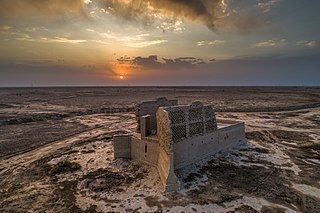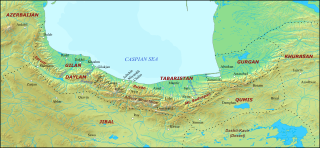
Yazdegerd III was the last Sasanian King of Kings of Iran from 632 to 651. His father was Shahriyar and his grandfather was Khosrow II.

The Lakhmid dynasty, referred to in Arabic as al-Manādhirah or Banu Lakhm, was an Arab kingdom in Southern Iraq and Eastern Arabia, with al-Hirah as their capital, from the late 3rd century to 602 CE. They were generally but intermittently the allies and clients of the Sasanian Empire, and participant in the Roman–Persian Wars. While the term "Lakhmids" has also been applied to the ruling dynasty, more recent scholarship prefers to refer to the latter as the Naṣrids.

The Muslim conquest of Persia, also known as the Arab conquest of Iran, was carried out by the Rashidun Caliphate from 632 to 654 and led to the fall of the Sasanian Empire as well as the eventual decline of the Zoroastrian religion.

Al-Hirah was an ancient city in Mesopotamia located south of what is now Kufa in south-central Iraq.

The Battle of Ullais was fought between the forces of the Rashidun Caliphate and the Sasanian Persian Empire in the middle of May 633 AD in Iraq, and is sometimes referred to as the Battle of Blood River since, as a result of the battle, there were enormous amounts of Persian Sasanian and Arab Christian casualties.

Sistān, also known as Sakastān and Sijistan, is a historical and geographical region in present-day south-eastern Iran and south-western Afghanistan. Largely desert, the region is bisected by the Helmand River, the largest river in Afghanistan, which empties into the Hamun Lake that forms part of the border between Iran and Afghanistan.
Al-Nuʿmān III ibn al-Mundhir, also transcribed Naʿaman, Nuʿaman and Noman and often known by the patronymic Abu Qabus, was the last Lakhmid king of al-Hirah and a Nestorian Christian Arab. He is considered one of the most important Lakhmid rulers.
Abū ʿAbd al-Raḥmān ʿAbd Allāh ibn ʿĀmir ibn Kurayz (626–678) was a Rashidun politician and general, serving as governor of Basra from 647 to 656 AD during the reign of Rashidun Caliph Uthman ibn Affan. He was a cousin of the Caliph through his father. He is known for his administrative and military prowess including his successful campaigns of reconquest and pacification of former territories of the Sasanian Empire in what is now Iran and Afghanistan.

Tabaristan or Tabarestan, was the name applied to a mountainous region located on the Caspian coast of northern Iran. It corresponded to the present-day province of Mazandaran, which became the predominant name of the area from the 11th-century onwards.

Hormuzan was a Persian aristocrat who served as the governor of Khuzestan, and was one of the Sasanian military officers at the Battle of al-Qādisiyyah. He was later taken prisoner by the Muslims after the fall of Shushtar in 642. Two years later, he was accused of the assassination of the Rashidun caliph Umar, and was killed by 'Ubaid-Allah, the deceased caliph's son.
Bahman Jādhūyah/Jādūyah, or Bahman Jādhawayh was an Iranian general of the Sasanians. He is mostly known to have led the Sasanians to victory against the Arabs at the Battle of the Bridge. The Arab Muslims referred to Bahman as Dhul Hājib. He had a reputation for being anti-Arab. He is often confused with Mardanshah, another Sasanian general.

The Arab conquest of Mesopotamia was carried out by the Rashidun Caliphate from 633 to 638 AD. The Arab Muslim forces of Caliph Umar first attacked Sasanian territory in 633, when Khalid ibn al-Walid invaded Mesopotamia, which was the political and economic centre of the Sasanian state. From 634 to 636 AD, following the transfer of Khalid to the Byzantine front in the Levant, the hold of Arab forces on the region weakened under the pressure of Sasanian counterattacks. A second major Arab offensive in 636 and ended in January 638 with the capture of Mosul and the consolidation of Arab control over and exclusion of Sasanid influence from the whole Mosul-Tikrit region.
Mihran-i Hamadani, known in Arabic sources as Mihran ibn Mihrbundadh, was a Sasanian military officer from the Mihran family. He was the son of a certain Mihrbandad, who is mentioned in some lines in a poem.

The Arab conquest of Fars took place from 638/9 to 650/1, and ended with subjugation of the Sasanian province of Pars, also known as Fars or Persis, to the Rashidun Caliphate under Umar.

The siege of Shushtar was fought from 641 to 642 between the Sasanian Empire and the invading Arab Muslims of the Rashidun Caliphate. Shushtar was an ancient strong stronghold in Khuzestan, and was attacked by the Arabs under their commander Abu Musa Ashaari. Although the city managed to resist the Arabs, the Sasanians later faced desertion, which resulted in the Arabs capturing the city and capturing its commander, Hormuzan.

Amghishiya was a Sasanian city or fortress located near the former Lakhmid capital of al-Hira. It was known as a major defensive headquarter. In 633, during the Muslim conquest of Persia, a battle took place in one of its satellite military posts, Ullais, where the Muslim Arabs defeated a combined army of Sasanian-Christian Arab troops. Amghishiya was thereafter invaded and sacked by the Muslim military officer Khalid ibn al-Walid, while the survivors of the place fled to the countryside.
Iyas ibn Qabisah al-Ta'i was governor of al-Hirah, the capital of the Lakhmid kingdom, from 613 to 618CE. He was the son of Qabisah al-Ta'i. He was also the father of Hayyah and Farwah. The last part of Iyas ibn Qabisah's name, al-Ta'i, indicates that he came from the Tayy tribe.

Pars was a Sasanian province in Late Antiquity, which almost corresponded to the present-day province of Fars. The province bordered Khuzestan in the west, Kirman in the east, Spahan in the north, and Mazun in the south.

Kirman was a Sasanian province in Late Antiquity, which almost corresponded to the present-day province of Kerman. The province bordered Pars in the west, Abarshahr and Sakastan in the northeast, Paradan in the east, Spahan in the north, and Mazun in the south. The capital of the province was Shiragan.